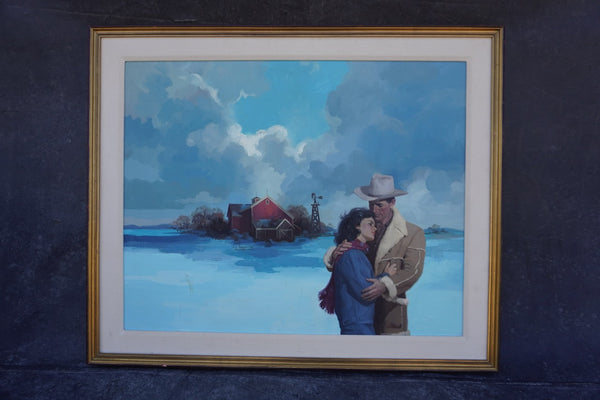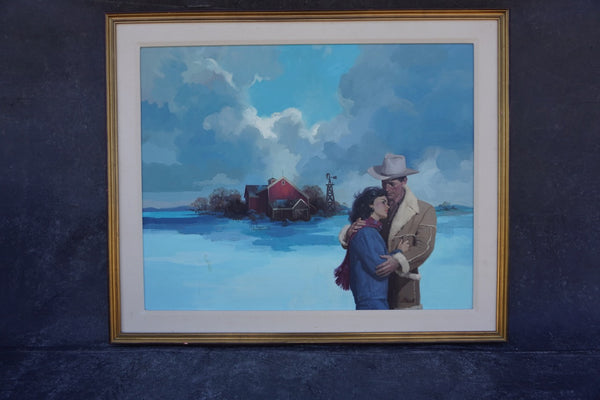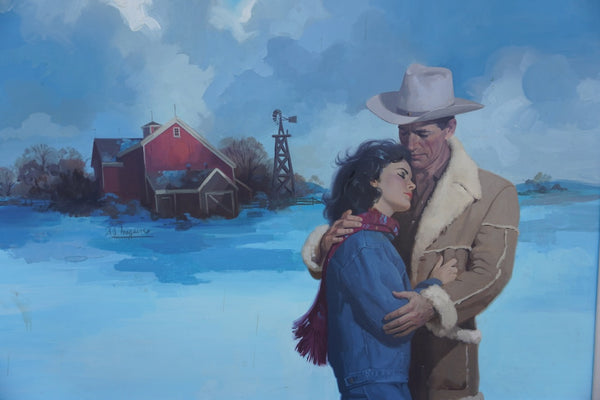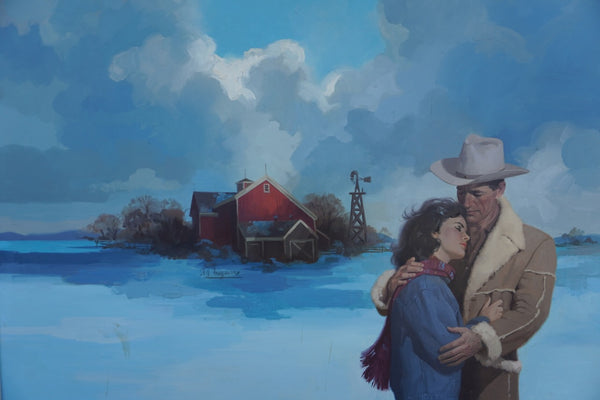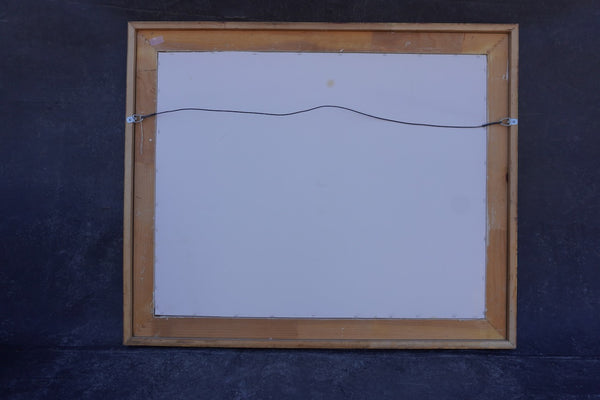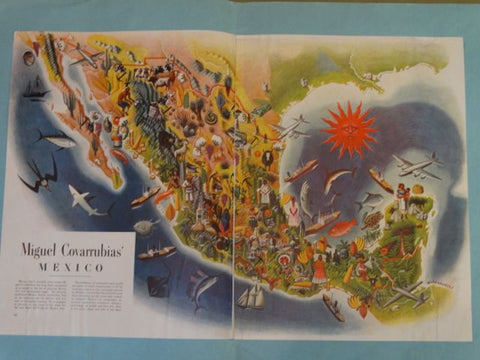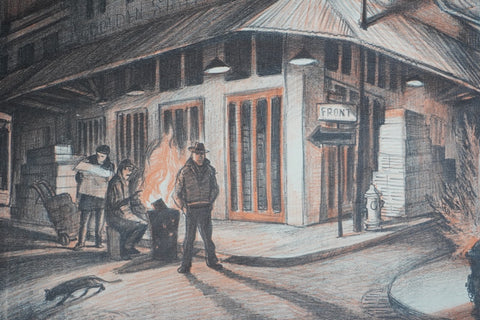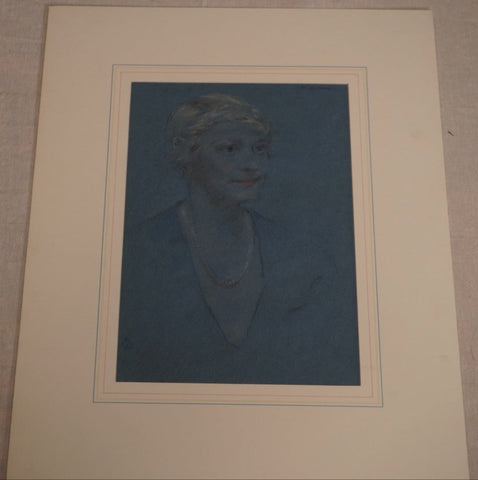Robert Albert Maguire (1921-2005)- Lovers in a Winter Landscape - Oil on Board P3319
A superb piece of Illustration art by one of its master-practitioners, and in its scale as well as its vision, as big as all outdoors. One of his classier efforts.
The art measures 28" x 35", and the frame is 34" x 41".
Contact us to arrange special shipping, local delivery, or pickup at the warehouse.
Robert Maguire, born in 1921 in New Jersey, painted over six-hundred paperback covers during a more than fifty-year career, mainly featuring luridly sexual females, for publishers including Pocket, Dell, Ace, Harper, Avon, Silhouette, Ballantine, Pyramid, Bantam, Lion, Berkeley, Beacon and Monarch. He made three to four thousand dollars per cover from Pocketbooks, for a time earning over one hundred thousand dollars a year. He also did work in watercolor for Norcross Greeting Cards, including Christmas cards of Santa Claus.
As a child, he was taught to draw by his father, an architectural draftsman, with drawing "contests" between them to see which of them could better draw a newspaper photo.,His education at Duke University, in Durham, North Carolina, was interrupted by World War II, when he served as a machine-gunner in Italy with the 88th Infantry. After the War, Maguire studied with Frank Reilly at the Art Students League, in New York City, finishing in 1949, with fellow students Jimmy Bama and Clark Hulings. Maguire's work was not considered good enough to get into Pratt Institute, Brooklyn, New York, but a friend's father recommended him to Reilly, and Maguire was accepted into his class, sitting, the first day, behind sixty people, barely able to see the model.
Maguire did not move West in the 1960s and 1970s when so many Eastern illustrators flooded the galleries and art world of Arizona and New Mexico, beginning new and lucrative careers as Southwestern fine artists painting landscapes, cowboys and Indians. He comments, "I think I liked painting beautiful women better, so cowboys and horses didn't appeal to me." Maguire worked for a time in New York with Tom Ryan, who went West, helping found the Cowboy Artists Hall of Fame.
Maguire didn't have time to read the books assigned to him for cover art. The people who hired him gave Maguire a synopsis, the girl's hair color, and how sexy she was supposed to beor pure, as they case might be. If there was a man and woman on the cover, Maguire would be told whether they were to be in a "clench" or "pre-clench"a full embrace or just touching. Maguire describes one of his models: "She'd say, 'how do you want me, zonked out of my mind or just mildly intoxicated?' She had it all down pat. She'd go into one of these sexual trances and look like she was crazy about the guy model."
When assigned a project, Maguire would submit half a dozen black and white sketches, then a "color rough" -- another sketch in color of the accepted version; finally the finished painting in oil on board, usually turning out three paintings a month.
Pulp paperback artists admired the work of the slick magazine illustrators, wishing they were allowed to paint more sophisticated designs. If they tried to do so, their editors would say something like, 'Why don't you just show the girls with the big boobs.' He painted a movie poster of Marilyn Monroe, but never did it again because the movie people were so dictatorial.
With work on book covers slacking off in the 1960s, Maguire went to work for the Norcross Greeting Card Company. He was pleased to be painting Christmas-related scenes like Christ in the Manger, and the Three Magi, instead of, as he says, "pretty girls being molested by bad guys." The cards were painted in gouache (a semi-opaque form of watercolor) in the size of the cards4 x 5 or 5 x 7. In his first greeting card, Maguire used his daughter as a model. Greeting card art was considered by the artists as a notch below paperback covers, as paper covers were a step below the magazines. Maguire would return to painting paperback covers.
From the late 1940s to the early 1960s, Maguire painted pulp covers for hard-boiled novels whose themes were usually a bad-girl doing (or about to do or just having done) a dirty deed, or a good-girl in trouble. In the 1970s and 1980s, Maguire continued to produce crime covers, but branched out to science fiction, medical romance and westerns. He also painted covers for best-selling paperbacks by writers like Herman Wouk and John Irving. After fifty years of painting paperback covers, Maguire left the field in the late 1990s because he perceived a trend to emphasizing the "financial bottom line" over creativity.
Robert Albert Maguire died on February 26, 2005.
Sources: http://www.ramaguirecoverart.com/index.html?bio.htmlmainFrame, http://www.americanartarchives.com/maguire.htm, and additional information supplied by his daughter Lynn Maguire.


